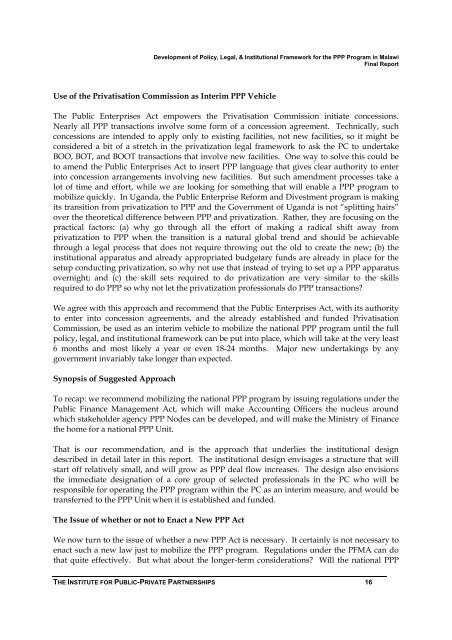Development of Policy, Legal, and Insitutional Framework for - ppiaf
Development of Policy, Legal, and Insitutional Framework for - ppiaf
Development of Policy, Legal, and Insitutional Framework for - ppiaf
You also want an ePaper? Increase the reach of your titles
YUMPU automatically turns print PDFs into web optimized ePapers that Google loves.
<strong>Development</strong> <strong>of</strong> <strong>Policy</strong>, <strong>Legal</strong>, & Institutional <strong>Framework</strong> <strong>for</strong> the PPP Program in Malawi<br />
Final Report<br />
Use <strong>of</strong> the Privatisation Commission as Interim PPP Vehicle<br />
The Public Enterprises Act empowers the Privatisation Commission initiate concessions.<br />
Nearly all PPP transactions involve some <strong>for</strong>m <strong>of</strong> a concession agreement. Technically, such<br />
concessions are intended to apply only to existing facilities, not new facilities, so it might be<br />
considered a bit <strong>of</strong> a stretch in the privatization legal framework to ask the PC to undertake<br />
BOO, BOT, <strong>and</strong> BOOT transactions that involve new facilities. One way to solve this could be<br />
to amend the Public Enterprises Act to insert PPP language that gives clear authority to enter<br />
into concession arrangements involving new facilities. But such amendment processes take a<br />
lot <strong>of</strong> time <strong>and</strong> ef<strong>for</strong>t, while we are looking <strong>for</strong> something that will enable a PPP program to<br />
mobilize quickly. In Ug<strong>and</strong>a, the Public Enterprise Re<strong>for</strong>m <strong>and</strong> Divestment program is making<br />
its transition from privatization to PPP <strong>and</strong> the Government <strong>of</strong> Ug<strong>and</strong>a is not “splitting hairs”<br />
over the theoretical difference between PPP <strong>and</strong> privatization. Rather, they are focusing on the<br />
practical factors: (a) why go through all the ef<strong>for</strong>t <strong>of</strong> making a radical shift away from<br />
privatization to PPP when the transition is a natural global trend <strong>and</strong> should be achievable<br />
through a legal process that does not require throwing out the old to create the new; (b) the<br />
institutional apparatus <strong>and</strong> already appropriated budgetary funds are already in place <strong>for</strong> the<br />
setup conducting privatization, so why not use that instead <strong>of</strong> trying to set up a PPP apparatus<br />
overnight; <strong>and</strong> (c) the skill sets required to do privatization are very similar to the skills<br />
required to do PPP so why not let the privatization pr<strong>of</strong>essionals do PPP transactions?<br />
We agree with this approach <strong>and</strong> recommend that the Public Enterprises Act, with its authority<br />
to enter into concession agreements, <strong>and</strong> the already established <strong>and</strong> funded Privatisation<br />
Commission, be used as an interim vehicle to mobilize the national PPP program until the full<br />
policy, legal, <strong>and</strong> institutional framework can be put into place, which will take at the very least<br />
6 months <strong>and</strong> most likely a year or even 18-24 months. Major new undertakings by any<br />
government invariably take longer than expected.<br />
Synopsis <strong>of</strong> Suggested Approach<br />
To recap: we recommend mobilizing the national PPP program by issuing regulations under the<br />
Public Finance Management Act, which will make Accounting Officers the nucleus around<br />
which stakeholder agency PPP Nodes can be developed, <strong>and</strong> will make the Ministry <strong>of</strong> Finance<br />
the home <strong>for</strong> a national PPP Unit.<br />
That is our recommendation, <strong>and</strong> is the approach that underlies the institutional design<br />
described in detail later in this report. The institutional design envisages a structure that will<br />
start <strong>of</strong>f relatively small, <strong>and</strong> will grow as PPP deal flow increases. The design also envisions<br />
the immediate designation <strong>of</strong> a core group <strong>of</strong> selected pr<strong>of</strong>essionals in the PC who will be<br />
responsible <strong>for</strong> operating the PPP program within the PC as an interim measure, <strong>and</strong> would be<br />
transferred to the PPP Unit when it is established <strong>and</strong> funded.<br />
The Issue <strong>of</strong> whether or not to Enact a New PPP Act<br />
We now turn to the issue <strong>of</strong> whether a new PPP Act is necessary. It certainly is not necessary to<br />
enact such a new law just to mobilize the PPP program. Regulations under the PFMA can do<br />
that quite effectively. But what about the longer-term considerations? Will the national PPP<br />
THE INSTITUTE FOR PUBLIC-PRIVATE PARTNERSHIPS 16
















